
- Home
- —
- Thurston Dart
- - Objets Dart
- - Dart Biography
- - Dart Remembered
- Little Feat
- Francis Tregian
- —
- Ingestre Hall
- Time Wasters
- Personal Records
- Album Covers
- —
- Performing
- YouTube Videos
- Sessions
- Arranging
- Tuition
- Music and Theatre
- Folk Club
- Special Occasions
- —
- A Life in Music
- Memorabilia
- Employment
- Qualifications
- Odds and Sods
- Contact
Little Feat
Greg passed away on 25 July 2020.
Donations in his memory can be made to British Heart Foundation.
His partner, Katy, will monitor his email if anyone wants to get in touch.
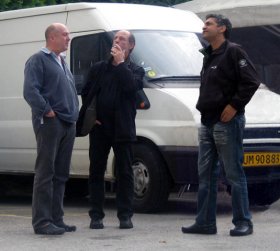
Greg with Paul Barrere and Kenny Gradney
Greg's research thesis, The Musical Nature of Rock (Keele, 1985), was probably the first MA on rock music in the United Kingdom. Chapter 7 concentrated on the special qualities of the music of Little Feat, who disbanded in 1979, after the death of Lowell George, and re-formed in 1987. Little Feat are still going strong today, albeit with a line-up that has changed several times over the years.
Greg has always felt that the combination of variation and nuance together with expressive power in the music of Little Feat is their characteristic achievement and represents a peak in the development of rock music.
Chapter 7 - Variation and Nuance in the Music of Little Feat
Chester pointed out[1] that in the aesthetic criteria of rock music, intensional development is accorded value. In the Open University Unit 16 Richard Middleton discussed the tension between formula and variation in the structures of music and observed that in Afro-American music:
"...the formulaic processes operate within the parameters relatively highly valued by traditional musicology: harmony, melodic shape, basic rhythmic pattern. Variation processes, on the other hand, often take place in parameters little valued by traditional musicology (and much harder to notate): slight pitch inflection or rhythmic variation, timbre and timbre changes, accent and attack."[2]
The music of the band Little Feat offers an opportunity to examine the use of variation and intensional development in rock. Unlike the individual artists discussed in the last chapter, who have no fixed group of accompanists, a band such as Little Feat, with a more-or-less permanent line-up are able to develop a corporate style over a period and apply it to the compositions of different members of the group.
Little Feat's style emerged slowly through the albums Little Feat (1971) and Sailin' Shoes (1972) which they made as a quartet: Lowell George, guitar, harmonica and lead vocals; Bill Payne, keyboards, accordion, lead vocals; Richard Hayward, drums, percussion and backing vocals; Roy Estrada, bass and backing vocals. The group was dominated by the singing, playing and composing styles of George and Payne. Separately or together they wrote all the original material. (Roy Estrada co-wrote one song on Little Feat and Richie Hayward co-wrote one on Sailin' Shoes.) George's slide guitar technique (in which he slides down the neck - i.e. down in pitch - more than up, contrary to blues bottle-neck tradition) and Payne's blues piano featured prominently in the arrangements.[3] Occasionally extra instrumention was played by sessions musicians. Ry Cooder, for example, played guitar on two tracks, "Willin''' and "Forty-four blues"/"How many more years", on the first album, which also had strings and horns on "Takin' my time".
Blues influence was strong. "Forty-four blues"/"How many more years" was a medley of two numbers by Howlin' Wolf (blues artist Chester Burnett) and idioms from blues were evident in the rhythms - the boogie rhythm of "Tripe face boogie" is reminiscent of such John Lee Hooker numbers as "Boogie chillun" and "Walkin' the boogie"; the cross-rhythms found on "A apolitical blues" and "Sailin' shoes" derive from the country blues where an artist such as Robert Johnson could fluctuate between dotted and even rhythms at will, in songs like "Crossroads".
Country and western influence was also evident in "Willin'" which was country in style in its melody, harmony and instrumentation (and lyric), with strummed acoustic guitar prominent.
Little Feat: "Willin'" - lead vocal
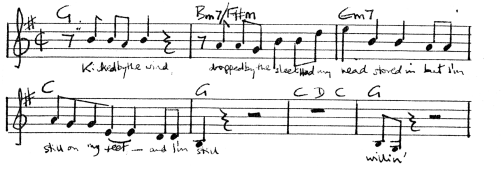
As such it contrasts sharply with bluesy numbers like "A apolitical blues".
Little Feat: "A apolitical blues" - lead vocal

Little Feat's music also shows the influence of contemporary rock groups. The Band (who started making their own records under this name in 1968, having previously recorded in other guises) set lyrics about scenes from American life to music with interweaving voices and instruments in a style with both blues and country echoes (e.g. The Band, 1969). Little Feat's "Hamburger midnight" on the first album sounds similar to some numbers by Captain Beefheart and His Magic Band[4] - e.g. "Sure 'nuff 'n yes I do" from Safe as milk, also known as Dropout boogie (1967), and "Gimme dat harp boy" from Strictly personal (1968) - in rhythm, vocal quality, slide tone and chord sequence.
A new line-up was formed for Dixie chicken (1973). Estrada was replaced on bass by Kenny Gradney, and Paul Barrere (guitar and lead vocals) and Sam Clayton (percussion and backing vocals) were added, Barrere contributing several compositions. This combination, plus female backing vocalists and occasional sessions musicians, created new textures in which the instrumentation was sparing and the pitched instruments, by each avoiding playing continuously, allowed a filigree of contrasting timbres to emerge, with drums and percussion providing rhythmic counterpoints to the interweaving of the guitars and keyboards. Great skill, discipline and taste were required in order to know not only what to play but also what to leave out. Feats don't fail me now (1974) and The last record album (1975) consolidated this approach.
A change of musical direction occurred with Time loves a hero (1977). Ted Templeman, who had produced Sailin' shoes, returned as producer, replacing Lowell George who had produced the last three albums. Tower of Power - a horn section, previously used on "Spanish Moon" from Feats don't fail me now - were now used to add trumpets, saxes and trombone to several numbers and funk and jazz-rock influences modified the previous contrapuntal boogie and blues style, often replacing it with thicker textures and fuller instrumentation (strings were added to some tracks) which created patterns of rhythmic counterpoints with more homophony and less antiphony than before.[5] The female vocalists were dropped, being replaced by male singing in the contemporary funk style of the Average White Band and the Doobie Brothers, two members of the latter - Patrick Simmons and Michael McDonald - singing on the song "Red streamliner". One number, "Day at the dog races", was a jazz-rock instrumental composed and performed without Lowell George by the other five members of the band.
Specific similarities between some Little Feat numbers and funk numbers by other artists can be identified. The recurrent phrase at the start of the chorus of funk group War's "The world is a ghetto" (1972) is also found in the choruses of Little Feat's "Old folks boogie" (which also start with similar lyrics - "And you know" or "So ya know").
War: "The world is a ghetto" - vocal line

Both the riff patterns around the blues scale and the usage of the horns in Ben E. King's "What is soul?" (1968) are very similar to those in Little Feat's "Hi roller" and the repeated keyboard phrase of "What is soul?" is found repeated by the lead guitar in "Hi roller".
Ben E. King: "What is soul?" - keyboard riff

Little Feat: "Hi roller" - guitar riff

A double live album followed - Waiting for Columbus (1978) - which contained new versions of previously released material. Various unofficial "bootleg" live albums have also been released.
The last official studio album, Down on the farm (1979), was completed after the death of Lowell George and is stylistically uneven, though some of it echoes earlier, archetypal Little Feat material. Hoy-hoy! (1981) is a mostly-retrospective souvenir album which contains previously released recordings, "out-takes" (i.e. recordings not hitherto deemed suitable for release) and live recordings as well as a few numbers not recorded by the whole band.[6]
Tonality, melody and harmony in Little Feat's music
The album Waiting for Columbus is a live album which draws its songs from all the previous studio albums. It thus affords a reasonable cross-section of the band's repertoire. The fifteen original songs contained on it can therefore easily be used as a sample for analysis. These are "Willin'", versions of which were included on both the first album Little Feat and the second album Sailin' shoes; "A apolitical blues" and "Sailin' shoes" from Sailin' shoes; "Tripe face boogie", different version of which were found on Sailin' shoes and the fourth album Feats don't fail me now; "Dixie chicken" and "Fat man in the bathtub" from the third album Dixie chicken; "Feats don't fail me now", "Oh Atlanta" and "Spanish Moon" from Feats don't fail me now; "All that you dream", "Day or night" and "Mercenary territory"from the fifth album The last record album; and "Old folks boogie", "Rocket in my pocket" and "Time loves a hero" from the sixth album Time loves a hero.
The vocal lines in the songs from Waiting for Columbus have a basis in blues, gospel or country and western.
Melismata occur in most of the songs. This example comes from "Dixie chicken".
Little Feat: "Dixie chicken" - lead vocal

This technique has been part of rock's vocabulary since Elvis Presley (from Memphis) and other rock'n'roll artists from the "Deep South", with their awareness of gospel music, employed it in the 1950s.
Elvis Presley: "Trying to get to you" (1956) - vocal line

The tessitura of the lead vocal parts in these Little Feat songs is broad - an octave and a minor seventh in "Tripe face boogie" and "Mercenary territory" - and never less than an octave and a minor third in all except one of the songs. This is in keeping with the expansive vocalisation found in black musical styles from which rock evolved.
The lead vocal melodies of the fifteen songs in the sample have compasses which fall into nine different types. For purposes of comparison all have been notated in C. ("Blue" notes are marked * and incidental notes are marked in brackets, unless the pitches are already present as blue notes.)
One song, "Tripe face boogie", uses a twelve-note, fully chromatic compass.

Eight songs use nine-note compasses. These are of three types:
- "Dixie chicken", "Rocket in my pocket", "Feets don't fail me now" and "Fat man in the bathtub"

- "Sailin' shoes", "All that you dream" and "Day or night"

- "Oh Atlanta"

One song, "Time loves a hero", uses an eight-note compass

Four songs use seven-note compasses but they are all different:
"Spanish Moon"

"Old folks boogie"

"Mercenary territory"

"Willin'"

One song uses a six-note compass:
"A apolitical blues"

These compasses have to be seen against the tonality of the harmonic bckgrounds. All the songs except one are in the major mode. However, they all, with exception of "Willin'" which has more of a C&W style, have "blue" notes in the vocal melody. That is, the pitches of the third, the fifth and the seventh are sometimes flattened. The "blue", flattened (minor) seventh occurs in all cases except "Mercenary territory" where it occurs as an incidental. The "blue", flattened (minor) third is found in ten of the songs, whilst "Spanish Moon", which has a minor drone throughout, uses "blue", flattened (diminished) fifths. In "Sailin' shoes" and "All that you dream", as well as minor thirds and and sevenths, augmented fourths/diminished fifths occur, as passing notes.
Little Feat: "Sailin' shoes" - lead vocal

This use of blues singing style accounts for much of the chromaticism found in the melody lines. Other chromaticism derives from abrupt, unprepared shifts of tonal centre or from modulations through a dominant chord. "Tripe face boogie" moves around chords which are harmonically distant in a manner idiomatic to the technique of forming chord shapes on the guitar fretboard. Here, for example, the chord sequence arrives at E major and this tonal base is established via the chords of G major, the flattened mediant, and C major, the flattened sub-mediant:
Little Feat: "Tripe face boogie" - lead vocal
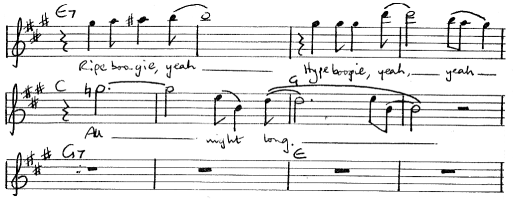
This use of the flattened sub-mediant is harmonically similar to its use in Bo Diddley's "Bo Diddley" (1955). There the tonal centre of G major is firmly established by repetition but to create some harmonic interest in the instrumental section between the second and third verses Diddley introduces the sub-dominant and flattened sub-mediant by sliding his chord shape up the fretboard and then down again to the tonic:[7]
Bo Diddley: "Bo Diddley" - rhythm guitar

In "Tripe face boogie" the use of chords which are only distantly related accounts for the unusual, twelve-note chromatic compass of the vocal line. As well as being the minor seventh of the tonic of A major, the note G occurs as the fifth of the C major chord; and the note F, the minor sixth of A, occurs as the minor seventh of the G major chord. The augmented tonic note A sharp occurs as the augmented fourth/diminished fifth of the dominant E major but it also occurs as the third of the chord F sharp major and the augmented fourth note D sharp occurs as the third of the chord B major when the music modulates to the major on the supertonic, B major, via its dominant F sharp seventh.
Little Feat: "Tripe face boogie" - lead vocal
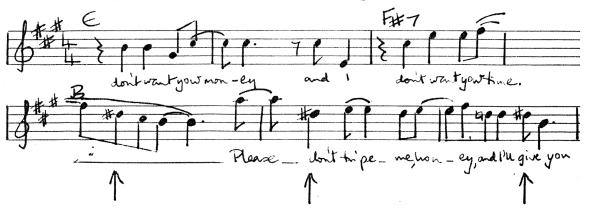
On "Time loves a hero" the minor sixth in the compass of the vocal melody arises from the sequential pattern of the chord sequence moving up and down.
Little Feat: "Time loves a hero" - lead vocal
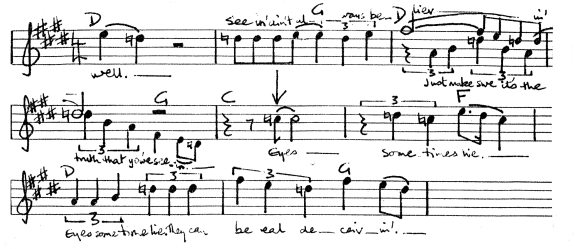
The augmented fourth in the compass of "All that you dream" arises from sliding chromatic harmonies passing through the major chord on the supertonic, as well as from passing notes.
Little Feat: "All that you dream" - lead vocal

This chord also produces the augmented fourths in the scales of "Oh Atlanta" and "Day or night". In these songs, and in "Rocket in my pocket", the major on the supertonic is used in modulations to the dominant as the dominant of the dominant. These examples of modulation, together with the modulation to the major on the supertonic in "Tripe face boogie", are the only uses of dominant to tonic modulation in the sample.
In being quite varied the tonality/modality of Little Feat songs reflects the range of melodic and harmonic types found in other rock music, as can be seen in the following examples of such types. They include the characteristic blues juxtaposition of flattened notes against major tonality, as in "Anyway" by Manassas (1972) with its flattened thirds and sevenths,
Manassas: "Anyway" - vocal line
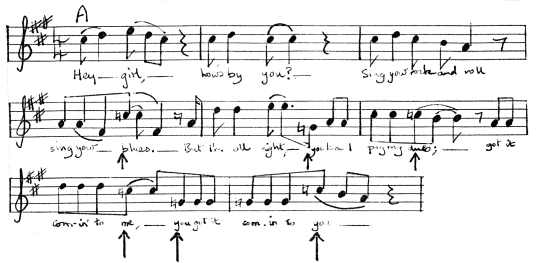
or as in Bob Dylan's "Rainy day women #12 & 35" (1966) with its flattened fifths and sevenths.
Bob Dylan: "Rainy day women #12 & 35 - vocal line
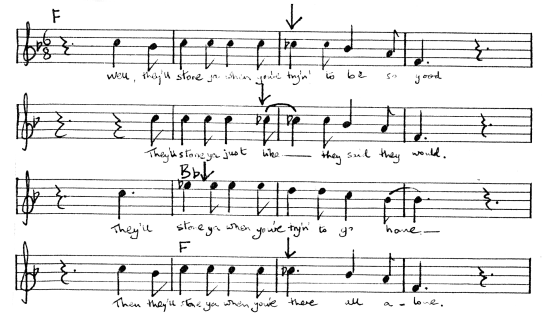

The flattened thirds and sevenths of the blues are sometimes set against melodic minor tonality as in "Money" (1973) by Pink Floyd.
Pink Floyd: "Money" - vocal line
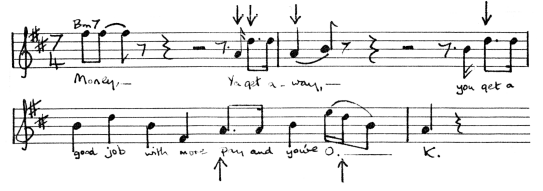
The hexatonic scale without blue notes is a very common melodic form. James Taylor's "Isn't it nice to be home again" (1971) is typical of many similar songs.
James Taylor: "Isn't it nice to be home again" - vocal line
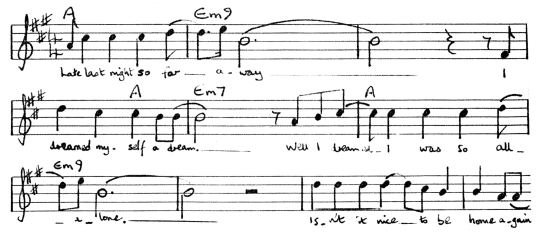
A hexatonic scale is sometimes found with blue notes added, as in "Rock and roll crazies" (1972) by Manassas,
Manassas: "Rock and roll crazies" - vocal line
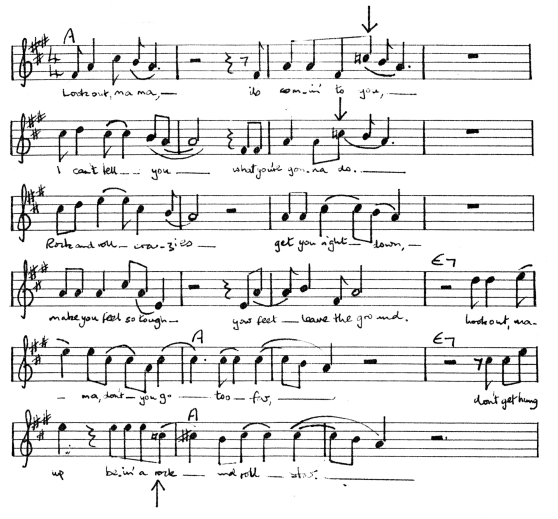
and sometimes with both blue notes and leading notes included, as in "Take it easy" (1972) by the Eagles.
Eagles:"Take it easy" - vocal line
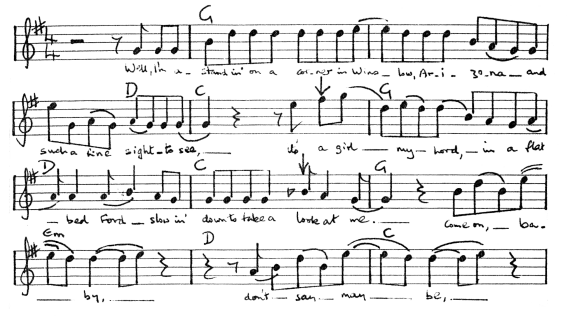
Completely diatonic tonality is found, as in Paul Simon's "American tune" (1973) which is based on a Bach chorale melody.[8]
Paul Simon: "American tune" - vocal line
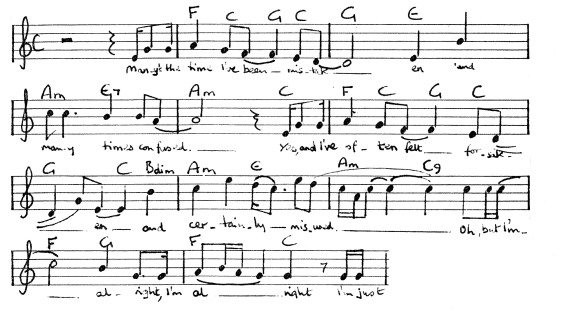
Chromaticism through modulation is also found, as in "I get around" (1962) by the Beach Boys.
Beach Boys: "I get around" - vocal line
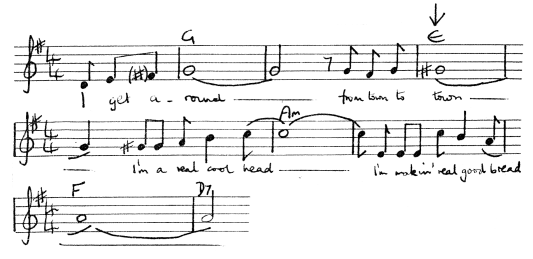
Alternatively, melodic chromaticism can arise from unprepared shifts in harmony (as in many songs by the Beatles)[9] often supporting a modal or a minor scale as in this example from "Eclipse" (1973) by Pink Floyd.
Pink Floyd: "Eclipse" - vocal line
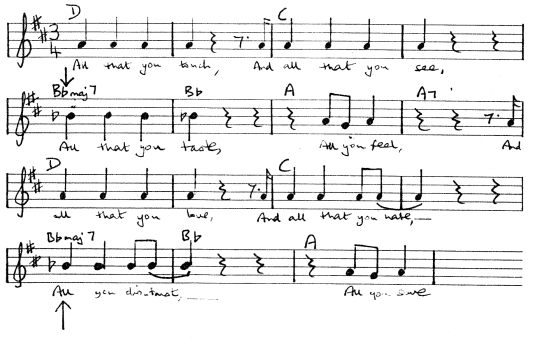
The tonality, melody and harmony of "Rock and roll doctor"
The tonality, melody and harmony of "Rock and roll doctor", as in rock'n'roll itself, are fairly simple. The key is E major and the chord sequence mostly consists of triadic chords on the tonic, the sub-dominant, the dominant and the subtonic. Sometimes triads have their minor sevenths added as harmonic colouration.[10] Usually the chords are in root position with the root note played by the bass guitar but exceptions to this are the first inversions on the sub-dominant during the slide guitar solo section. Here the bass guitar, after a bar of sub-dominant root position, moves up from the A to play C sharp for a bar of first inversion. Because the effect is exceptional (in terms of rock music norms) it has structural significance. In the studio version it marks the beginning of the solo and occurs in both of the two opening four bar phrases. In the live versions it occurs at the beginning of the solo and then once or twice more, depending on the length of the solo, at intervals of thirteen bars, thus giving proportions to the section.
The instrumentation on this piece is bass guitar, drums, a pair of cabasas, piano (electric piano on the Electrif lycanthrope, Rampant synchopatio and T.V. versions) and two electric guitars (Fender Stratocasters), one of which uses slide technique. ("Horns" are added on the Hoy-hoy! version.)
Form and texture
The innovation of Little Feat's music lies not in the melodies or harmonies per se but in the structures and textures into which they are formed. A balance of variety and coherence and of sublety and power is achieved by the avoidance of much repetition and symmetry and by adherence to an open texture which creates a filigree of sonorities in rhythmic and harmonic counterpoint in many of their most characteristic numbers.
- Textural and rhythmic variation
- Formal variation in different performances
- Variation in structural units
- Variation and unification of thematic motifs
The key to the open texture is the omission of a strumming rhythm guitar which is usually present in rock music to provide a harmonic and rhythmic layer of continuous sound and which would normally rely on superimposed "lead" instruments to provide contrast and variation. This omission is unusual and significant.
Other American rock bands contemporary with Little Feat, such as the Band and the Eagles, retained the practice of having at least one chordal instrument, most often a guitar, piano or organ, or combination of these, to fulfill the harmonic/rhythmic function which is comparable to the continuo in Baroque music. This technique could be employed with great subtlety and variety in the interweaving of instruments as in, for example, such Band albums as Music from Big Pink (1968) and The Band (1969). The homophonic dimension remained, however, to solidify the sonorities. In the music of the Eagles, and others, string sections were sometimes added to thicken and sustain textures and harmonies, for example on Desperado (1973) and One of these nights (1975).
Little Feat, in much of their music, replaced this homophony with arrangements in which the instruments contribute phrases antiphonally and polyphonically to the ensemble and thus create a composite texture of contrapuntal harmonies, polyrhythms and varied timbres.[11] This texture has more interest than a repetitive one, without sacrificing the rhythmic drive and sonorous impact characteristic of rock. Instrumental solos and vocal lines are juxtaposed with the nuances of the accompaniment rather than superimposed on a chordal background.
In "Rock and roll doctor" none of the pitched instruments plays continuously. The constant rhythmic impetus is created by the drums and cabasas. The drummer varies the accents in embellishing a basic 12/8 rhythm on the hi-hat cymbal

and a snare drum pattern of hitting beat three of the quadruple pulse

whilst the cabasas play something like

The interplay of phrases added by the players adds nuances of rhythm, counterpoint and timbre.
The variety in Little Feat's performances, born of spontaneity and improvisation, is captured on their live recordings. The four "bootleg" albums together with Waiting for Columbus and parts of Hoy-hoy! provide enough material for comparisons to be made of individual songs in different performances. It is clear that each live performance of a particular song differs from other live performances of it as well as from the studio version.
Five performances of "Rock and roll doctor" - the studio version on Feats don't fail me now, live recordings on Hoy-hoy!, Electrif lycanthrope and Rampant synchopatio and the live television performance on the B.B.C. programme The old grey whistle test (17th January 1975) - all differ in duration and in the proportions of the individual sections of the piece.
The lyric of the song has a verse/chorus format with an additional "bridge" section. The verses and choruses have a tripartite structure akin to blues lyrics.
Verse:
There was a woman in Georgia didn't feel just right:
She had fever all day and chills at night.
Now things got worse, yes a serious bind:
In times like this it takes a man of some style like you can not often find,
A doctor of the heart and a doctor of the mind.
Chorus:
If you like country with a boogie beat
He's a man to meet.
If you like the sound of shuffling feet
He can't be beat.
If you, if you wanna, if you wanna feel real nice
Just ask the rock and roll doctor's advice.
Verse:
Well it's just a country town but patients come
From Mobile to Moline, from miles around,
Nacogdoches to New Orleans,
In beat-up old cars or in limousines,
To meet the doctor of soul -
He's got his very own thing.
Bridge:
Two degrees in bebop, a PH.D. in swing,
He's a Master of Rhythm, he's a rock and roll king.
Chorus:
If you like country with a boogie beat
He's a man to meet.
If you like the sound of shuffling feet
He can't be beat.
(I said up, I said down,
I said in, I said out,
I said up, down, in, out.)
If you, if you wanna, if you wanna feel real nice
Just ask the rock and roll doctor's advice.
(The additional lyrics in brackets in the second chorus are absent in the studio version and vary in the live ones. This example is taken from the T.V. version which seems to me to be the most typical.)
The approximate duration, in seconds, of each section of the song is as follows.
|
|
Feats don't fail me now |
Hoy-hoy! |
Electrif lycanthrope |
Rampant synchopatio |
T.V. |
|---|---|---|---|---|---|
|
Instrumental introduction |
12 |
12 |
12 |
12 |
12 |
|
Verse 1 |
26 |
28 |
29 |
30 |
28 |
|
Chorus 1 |
27 |
22 |
30 |
32 |
29 |
|
Verse II |
20 |
22 |
22 |
24 |
22 |
|
Slide guitar solo |
31 |
28 |
50 |
54 |
49 |
|
Bridge |
14 |
14 |
15 |
42 |
19 |
|
Chorus II |
28 |
40 |
40 |
50 |
42 |
|
Coda |
17 |
17 |
17 |
18 |
15 |
|
Total duration |
2' 55" |
3' 10" |
3' 35" |
4' 22" |
3' 36" |
Allowing for slight differences in the tempos of the performances it is clear that individual sections vary considerably in length from one performance to another.
Dividing the pulse into measures of compound quadruple time allows nominal bars of 12/8 to be counted for each section. Pulse and pitch are constant in each individual performance. The duration divided by the total number of bars gives an approximate measurement of the tempo in each case. The number of bars of 12/8 in each section is as follows.
|
|
Feats don't fail me now |
Hoy-hoy! |
Electrif lycanthrope |
Rampant synchopatio |
T.V. |
|---|---|---|---|---|---|
|
Instrumental introduction |
7 |
7 |
7 |
7 |
7 |
|
Verse 1 |
16 |
16 |
16 |
16 |
16 |
|
Chorus 1 |
17 |
17 |
17 |
17 |
17 |
|
Verse II |
13 |
13 |
13 |
13 |
13 |
|
Slide guitar solo |
20 |
16 |
29 |
29 |
29 |
|
Bridge |
9 |
9 |
9 |
23 |
11 |
|
Chorus II |
18 |
24 |
24 |
28 |
26 |
|
Coda |
9 |
9 |
9 |
9 |
9 |
|
Total number of bars |
109 |
111 |
124 |
142 |
128 |
|
Approximate tempi |
|
|
|
|
|
The variations in length of the slide guitar solos are due to the element of improvisation in each performance. The variations in the length of the bridge sections arise from the five bar vocal phrase, which is common to all the performances, being followed by different numbers of instrumental bars in each case before the entry of the second chorus. The second chorus itself varies in length because the live versions have the additional lyrics which add six bars to the length and because there are differences in the number of bars which occur between vocal phrases. The Feats don't fail me now, Hoy-hoy! and Electrif lycanthrope versions have two bars after
If you like country with a boogie beat
He's a man to meet
and after
If you like the sound of shuffling feet
He can't be beat
whilst the T.V. version has three bars in each case and the Rampant synchopatio version has four.
Variations in the structure of the piece "Rock and roll doctor" occur in each performance but within any one version there is the variety of the different sections. Even though there is a verse/chorus structure the verses differ from each other, as do the choruses. Thus the song is virtually through-composed with little repetition or symmetry in the overall form.
This lack of symmetry is also found in the phrasing within individual sections. This simplified chart of the phrasing in relation to the number of 12/8 bars in each section demonstrates how uneven and varied the phrasing is. The Feats don't fail me now (studio) version is used in this analysis. (To simplify this chart the lengths of phrases have been approximated and parts of slide guitar phrases that overlap with vocal phrases have been omitted.)
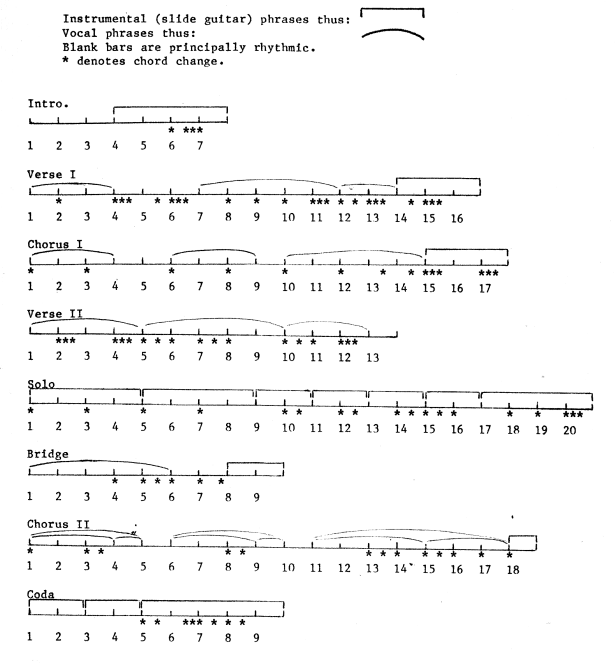
This degree of asymmetry is unusual in rock music where strophic structures and repeated chord sequences predominate. It contrasts completely with, for example, John Lennon's "Imagine" from the album of the same name (1971) which has symmetry of phrases, of verses and of choruses.
John Lennon: "Imagine" vocal line verse sequence
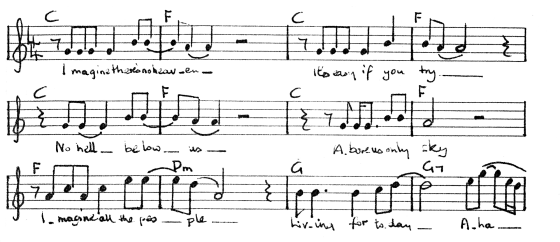
John Lenon: "Imagine" vocal line chorus sequence

These techinques were also used by Little Feat on slow songs and "Long distance love" from The last record album is a good illustration of this.
Little Feat: "Long distance love"
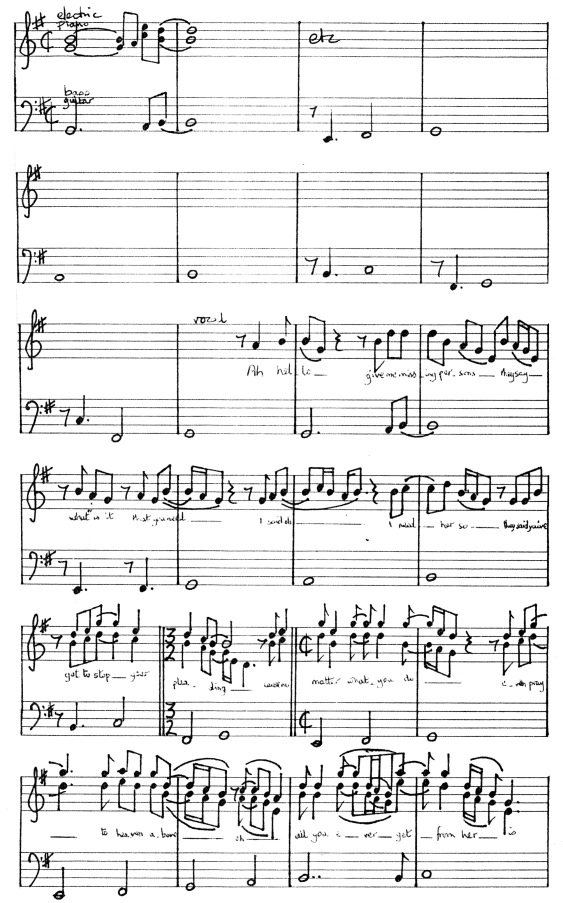
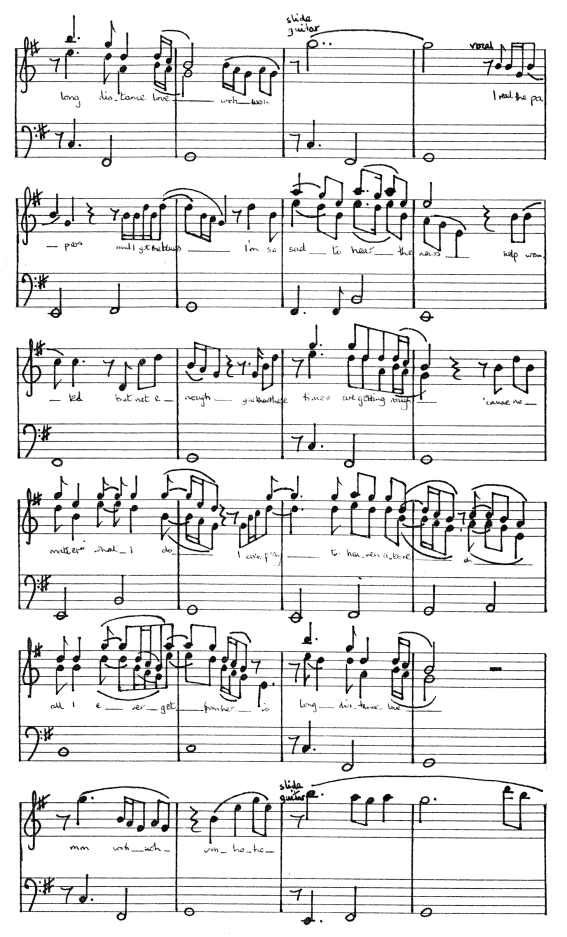
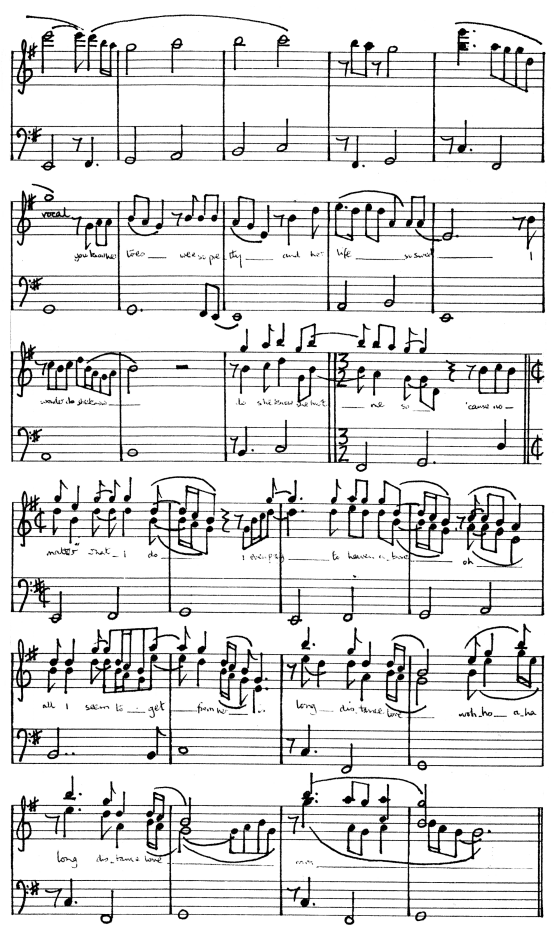
It has a modal melody in the lead vocal which uses these notes:
Little Feat: "Long distance love" scale of lead vocal line

The tonality is G major. There is no modulation. The instrumentation is bass guitar, drums, congas, electric piano and acoustic and electric guitars (using multi-tracked recording), one of which uses the slide technique. The lead vocal is in the tenor range and there are two female backing vocalists.
The song is through-composed except for the repetitions of the chorus (which are themselves slightly varied). The tempo and pitch are constant. The pulse can be divided into bars of 2/2 with occasional 3/2 bars. The approximate tempo measurement is minim ![]() = 60.
= 60.
|
|
Number of bars of 2/2 |
Approximate duration in seconds |
|---|---|---|
|
Instrumental introduction |
10 (8+2) |
20 |
|
Verse 1 |
7 +1 of 3/2 |
18 |
|
Chorus 1 |
10 (8+2) |
20 |
|
Verse II |
8 |
17 |
|
Chorus II |
10 (8+2) |
20 |
|
Slide guitar solo |
8 |
17 |
|
Verse III |
7 +1 of 3/2 |
18 |
|
Chorus III |
12 (8+2+2) |
26 |
|
Totals |
72 +2 of 3/2 |
2' 36" |
The song is concise in its structure. Essentially it is formed of four-bar phrases, grouped in pairs in the verses and choruses, which make sixteen-bar sections (verse/chorus). Additional bars break up the symmetry (again in contrast with "Imagine"). The slide guitar solo is brief. The accompaniment is sparing and, as in "Rock and roll doctor", consists of subtle harmonic and rhythmic counterpoints.
The bass part in this song is particularly interesting, for while fulfilling a harmonic role and contributing rhythmic variety, it also provides a unifying element in the structure.
It is able to do this because the chord sequence contains two recurring patterns: (1) a stepwise ascent of the G major scale; (2) a progression to the relative minor.
The harmonic sequence of the song is as follows
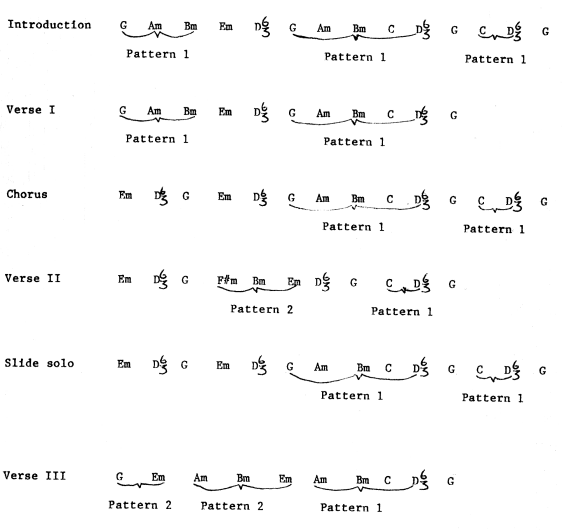
Em to D and D to G don't appear to fit either pattern but because D is in the first inversion the stepwise ascent of Pattern 1 appears in the bass line as the notes E to F sharp and F sharp to G. The chords G to C do not fit the pattern but this sequence only occurs at cadences and then (with one exception) only because the C D G cadential sequence is repeated forming C D G - C D G. The whole of the rest of the song consists of one or other of the patterns in either the chords or the bass line or both.
The stepwise ascent of Pattern 1 and the progression to the relative minor in Pattern 2 appear in the bass part in various sequences and can, for purposes of strucural analysis, be reduced to nuclei of (mostly) three notes. Pattern 1 can be reduced to a nucleus of three ascending pitches which occur in three forms.
1a
1b

1c
 (the note B is sometimes repeated)
(the note B is sometimes repeated)
Form 1b has a cadential variation which can be called 1b (ii).
1b (ii) 
There are two subtle variants of 1b which I have omitted from the analysis because they are not significant structurally. They are

which occurs at the beginning of the second chorus and

which occurs at the beginning of the third chorus and is just 1b with an additional note, D, on the upbeat. Though these examples are not significant in terms of the analysis of the structure they do illustrate the presence of variation in the repetitions of the chorus.
Pattern 2 also has three forms.
2a
2b

2c

The following notation of the pitches of the bass line (the rhythms being omitted in the interests of clarity) clearly shows the structural significance of the two patterns. It should be noted that elisions occur between certain pattern forms - 1c and 1b(ii); 2a and 1b - and that 1b to 1c contains form 1a.
Little Feat: "Long distance love" - bass patterns
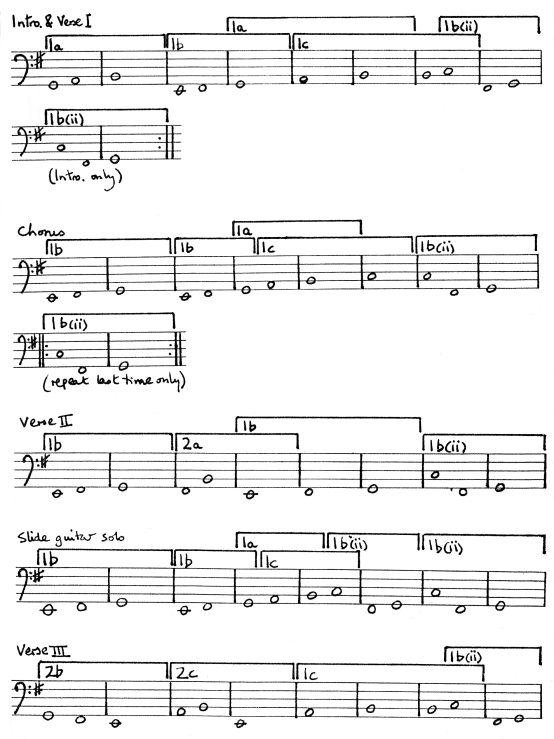
Although the adherence of the bass line to these patterns is a unifying element in the piece, the rhythms which are given to these patterns are a source of considerable variety. Including the forms elided or contained within other forms the following rhythms appear.
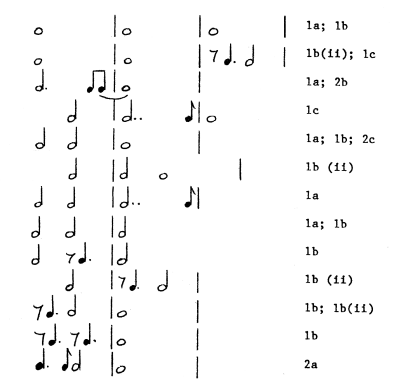
The degree of nuance and variation found in Little Feat's music is exceptional in rock. A considerable contrast to "Long distance love" is seen in the Eagles' song "Desperado" from the album of the same name (1973).
Eagles: "Desperado" lead vocal


Though similar to "Long distance love" in its pitch, tempo, melody and harmony "Desperado" is homophonic throughout and seeks to make its effect through the gradual increase of instrumentation and the consequent thickening of the sonorities and the emphasis of the rhythmic accents.
The combination of subtlety and expressive power in the music of Little Feat is their characteristic achievement, the great dilemma of rock having always been to expand its stylistic and emotional range from the limited parameters of rock'n'roll without becoming effete through eclecticism and diluting the expressiveness of the musical traditions from which rock sprang.
NOTES
1. Chester, Andrew, "Second thoughts on a rock aesthetic: the Band" in New Left Review, 1xii (1970), p.79.
2. Middleton, Richard, "'Reading' popular music" (Open University, Popular culture, unit 16), p.17.
3. The two guitar, keyboard, bass and drums format was a standard rock group line-up by the early seventies but the inclusion of a slide guitar specialist was unusual. Groups such as the Rolling Stones had made occasional use of the slide technique in the 1960s as an element in an R&B-based style - e.g. on "I'm moving on" from Got live if you want it (1965) and "Love in vain" from Let it bleed (1969) - but only a few rock bands had made regular use of this technique, notably the Allman Brothers Band (formed 1969) with Duane Allman on slide. The use of a permanent percussion specialist in a group line-up had begun with such as bands as Santana (formed 1969), War (formed 1969) and Manassas (formed 1971).
4. Ry Cooder, who played on Little Feat, though not on the track "Hamburger midnight", also played on Captain Beefheart and His Magic Band's first album Safe as milk, also know as Dropout boogie (1967).
5. Other, earlier jazz forms were also alluded to in Little Feat's music. The version of "Dixie chicken" on the live album Waiting for Columbus, for example, has episodes in which Bill Payne plays in a variety of jazz piano styles including that of Fats Waller. There is also a cameo New Orleans-style jazz band section played by Tower of Power. These jazz elements underlined the viruosity of the band and made for variety but they were incidental to the style that is most characteristic of Little Feat.
6. Lowell George released a solo album, Thanks I'll eat it here, in 1979. Paul Barrere has subsequently released On my own two feet (1983). Neither has more than passing similarities to the ensemble style of Little Feat.
7. The use of both the flattened sub-mediant and the flattened mediant is not uncommon in rock chord sequences. For example, the chorus of "Gimme some lovin'" (1966) by the Spencer Davis Group has a chord sequence which moves, at four beat intervals, from the tonic G major, through the flattened mediant Bb major, the sub-dominant C major, the flattened sub-mediant Eb major and back to the tonic. These chords seem to follow steps in a harmonic minor scale though the key is major.
8. The chorale melody used for "O sacred head", "Be near me, Lord" and "Commit thy way to Jesus" in the St. Matthew Passion.
9. O'Grady, Terence J., "The music of the Beatles from 1962 to Sergeant Pepper's
Lonely Hearts Club Band" (University of Wisconsin-Madison Ph.D thesis 1975).
O'Grady, Terence J., The Beatles: a musical evolution (Boston, 1983).
10. This use of the minor seventh is described as "colouristic harmony derived directly from the harmonic series" in Shepherd, John, Virden, Phil, Vulliamy, Graham and Wishart, Trevor, Whose music? A sociology of musical languages (London, 1977), p.171.
11. This technique has parallels in reggae which, whilst usually having chordal instruments playing repetitively, uses them for staccato, off-beat rhythms that leave enough space for polyrhythms and counterpoints in the polyphonic/antiphonal texture.
Copyright Greg Holt © 2006-11